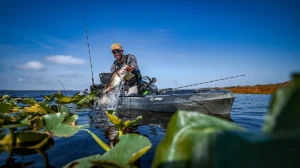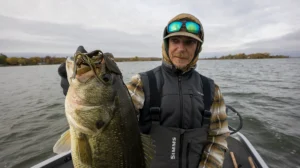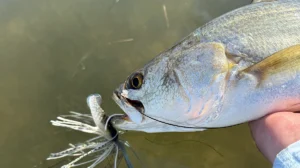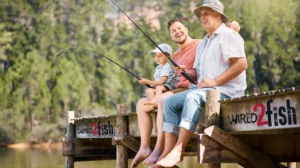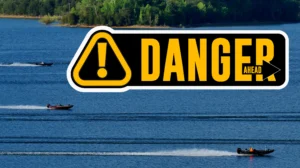We’ve been fishing bass a lot lately as per usual here at Wired2Fish, but the hotter it gets, the more we are fishing real early and real late in the day. That’s been leading us to low light and no light periods of the day or night as the case might be some fishing trips. Night fishing can seem like a daunting way to chase bass, but it’s really not that big a deal. Your plans for night fishing for bass should be very similar to your day plans, except for one general rule: the bass lose a lot of their apprehension to shallow areas when the sun goes down. This will help you learn how-to night fish for bass.
One of our most productive ways to catch fish the past few weeks in the low light to night time periods has been a single Colorado blade short-arm spinnerbait. There a bunch of good ones on the market. We’ve stuck mainly with the Cumberland Pro Lures Short Arm, Stan Sloan’s Zorro Aggrivator short arm and Accent short arm spinnerbaits. We’ve also dabbled a bit with the Canadian-produced KoManChi spinnerbaits.
Another key ingredient to good nighttime spinnerbait fishing is a good trailer. For the longest time, all I ever used was Uncle Josh Pork frogs, and I still use them a lot. But I also use a plastic trailer when it gets real hot like it is now. The Pork is great about holding a scent but we’ll get to that more in a minute. For plastic trailers a big grub is good but I’ve been having a lot of success with a Zoom G-Tail worm. I bite all but about last 3-4 inches of the tail off and use it as a trailer. It works great. I like an all black trailer.
Nighttime tackle
Nighttime spinnerbait tackle selection depends largely on the type of water. If it’s not heavily laden with cover, you can get away with 12-pound fluorescent mono. We’ve been throwing a lot of 15-pound Original Stren fluorescent blue monofilament on our 6-foot, 8-inch St. Croix Mojo bass rods with a 5.4:1 Lew’s Speed Spool or 5.4:1 Revo Winch. We like a slower gear ratio reel to maintain good bottom bumping contact.
Nighttime spinnerbait areas
The areas we are targeting range from shallow flats, ledges with shallow water on top, brush piles, stump beds, rip rap points and 45-degree banks. It seems like if you can keep the spinnerbait ticking the cover and bumping some ambush point, the fish are taking the spinnerbait pretty savagely. The steeper the banks the more we walk the spinnerbait down the slope with a lift and drop retrieve.
The key also seems to be going to the right spot at the right time. One thing we’ve learned recently is the fish are really finding those feeding zones in the last hour of daylight and then they are getting in more traditional places after the sun is completely down and darkness sets in. They will be there first break of dawn and then move back on those feeding/ambush zones as the sun starts coming up.
That may be confusing at first, but basically it means find areas like points, stumps, or other cover where a bass can roam and feed quickly before the light is gone or before it gets up to bright. Then as it transitions from one to the other, move to broader staging areas like ledges, flats in the mouths of bays, humps, etc.
Dark hour retrieves
The retrieve can vary but for me two retrieves work better than most. One is a pull and pump and the other is just a straight slow crank. The pull and pump is a side to side pull of the rod to slowly thump the blade along the bottom and then as I move my rod from right back to left to do another pull, I reel my slack quickly, always keeping a semi-taut to taut line.
On a straight retrieve, I will hold the rod fairly loose so that I’m in tune with the thump of that single blade. If I feel the thump turn to mush or jar suddenly, I get good tension on the line with the reel and lean into the fish hard.
Folks think you have to do something you never do during the day at night. The key is to be around cover or be in shallower feeding areas. You might catch some fish way out deep, but your more likely to find fish up on the banks, on shallow flats and ledges or humps at night where they don’t have the sun and boat pressure to drive them off those shallower areas.
A full moon can often make the fish bite a little better at night, and crawfish often molt on full moons in the summer months at night, which can also make a jig bite pretty good around the full moon.
Keep your bait moving in a straight line as much as possible. Predator fish have to use all their senses to help hone in on a target at night. The more you make it duck and dart, the harder it is for the fish to find and react to your lures.
Scent and color
Adding scent and sound can again improve your odds. Adding rattles on the arms or hooks of bass spinnerbaits can be a good idea. That extra sound again helps a bass hone in on your offering. Scent can do a lot at night when their sense of vision is greatly diminished. Pork really holds added scent well.
Colors at night are more important than you think. Generally speaking you want a dark solid color. The bait should create a silhouette to the fish. If your bait is more transparent, especially on brighter nights or around lighted areas like boat docks, it might not cast a full silhouette in the dark like a solid black or black and red lure might.
I’ve caught a bunch of bass just picking a bay and running the banks and fishing everything in between, but it seems like if you get on some of the shallower off the beaten path stuff out away from the banks it can be even better. Humps, bars in the mouths of bays, long extending secondary points and more can produce a lot of fish and often better fish. And for some reason stumps and brushpiles really seem to produce at night.
We’ve found that magic hour that used to be our least productive time of the evening night has turned out much better in recent outings. We’ve been moving around and hitting several quick shallow spots where we think a fish might move up and feed. If the wind is blowing in on a point or a grassy area, we’ll breeze through as many as those productive spots as we can in that hour as the sun sets. It’s produced a lot of bass for us lately, some more than 5 pounds.
So don’t go off the beaten path just because it’s dark. In fact, go to those shallower areas where you wanted the bass to be during the day, and fish around cover where possible. Think about the areas fish would ambush and chase prey for a quick meal before dark and hit as many of those spots quickly.
Making nighttime fishing more comfortable
Several non-fishing items will make your night fishing with a spinnerbait more fun and less hassle. Here’s a quick run down of some essential add-ons and why you want them:
- Bug spray – I’ve been using a lot of Off! and Reef Safe Back Country Expedition to keep unwanted bugs away.
- Headlamp – I keep a headlamp strapped to my head before and after dark. It just makes tying baits, getting a good bead on the bank, warning oncoming boats and more very simple.
- Blacklight – again being able to watch your line to know when it’s on the bottom, see a quick thump you didn’t feel and see the bank without shining a light and possibly spooking fish can help land a lot more bass. I’ve been using the Lightning Bug from Zorro Bait Company.
- Spotlight – GPS is a great tool for staying in the channel as you run from spot to spot. But it won’t show you other boats, buoys, obstructions like flocks of geese and other things that can be a nightmare to hit in the dark.
- Landing Net – A good landing net will really make fishing more enjoyable. If you think a mean bass is hard to land during the day, try doing it without any lights. They can be hard to track and the net just makes getting them in the boat a lot easier.
Take these tips with you on your next bass fishing evening adventure and it may extend a good day of fishing into an awesome night of bass fishing after dark!





